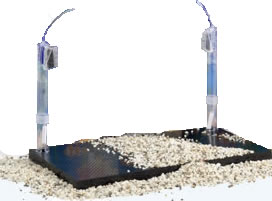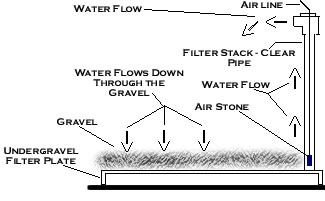Aquarium Filtration
Types Of Aquarium Filtration
Modern aquarium filtration can be divided into three basic types : Mechanical filtration, Biological filtration, and Chemical filtration.Mechanical filtration is the physical process of removing larger particulate matter from the water column. Common mechanical filtration sources may include: filter floss, foam inserts, and diatomaceous earth. It is important to rinse out mechanical filter media and replace as necessary. In most filter systems mechanical filtration is employed first before the water at goes through the biological filter. This helps prevent the biological filter media from becoming clogged with particular matter which will reduce the biological filters surface area.
Biological filter media provides a large surface area for live beneficial bacteria (nitrosomonas and nitrobacter) to cling to. Beneficial bacteria can then break down waste products such as ammonia and nitrite which come from decomposing organic matter like fish waste. Ammonia and nitrites are toxic to fish, levels above zero can be considered potentially deadly. The actions of beneficial bacteria are what keep your water clear and habitable for fish. Beneficial bacteria is essential to keeping fish alive in any aquarium, saltwater or freshwater. Chemical filtration employs chemical media to absorb gases, heavy metals and other foreign materials from the water. The most common type of chemical filtration used in aquariums is carbon. Carbon removes fish odors and discoloration from your water and will also remove medication. Another common type of chemical filtration is phosphate remover. Phosphate remover will absorb phosphate from your water which is the leading cause of pest algae. These types of contaminants cannot be removed with biological filtration or mechanical filtration.
With an understanding of the three basic filter concepts we can move on to water flow. It is important to have water movement in your aquarium for several reasons. Moving the water around in the aquarium improves gas exchange by exposing more of the water to the surface air. This allows carbon dioxide to be exchanged for oxygen. Oxygen is important for the fish so they don't suffocate and also for the beneficial bacteria we want to grow in the filter. With increased oxygen levels bacteria's and enzymes can also break down the fish waste that accumulates in the gravel. With the aquarium filter providing proper circulation particulate matter can be picked up by the filter and removed.
For freshwater aquariums you want to turn over the total volume of the aquarium through the filter three to 10 times per hour.
Example: 100 gallon aquarium turned over five times would be 500 gallons per hour.
For saltwater aquariums you want to turn over the total volume of the where through the filter five to 10 times per hour.
We will cover four different types of filtration systems they include under gravel filters, outside power filters, canister filters, wet dry filters.
Under Gravel Filter System

Under gravel filters have been around for probably 20 years. If you decide too use an undergravel filter I would recommend using it in conjunction with an outside power filter.Adding an outside hang on power filter will increase the circulation and help with mechanical and chemical filtration.
Undergravel filters provided primarily biological filtration and some mechanical filtration but little or no chemical filtration depending on the brand.

An undergravel filter is made up of a plate that sits below the gravel bed. In each corner of the aquarium there is a clear pipe attached to the under gravel filter plate, usually with an air stone inside the tube or a powerhead on the top. As the water is being drawn up the pipe water is being drawn through the gravel bed. The gravel bed provides tremendous surface area for beneficial bacteria it also does provide some mechanical filtration. One of the problems with an undergravel filter is all of the organic waste and particular matter is pushed into the gravel bed and underneath the under gravel filter plate making it difficult to remove. Make sure to use a gravel cleaner when you clean your aquarium, it will help remove some of the waste trapped under the filter plate. Also if you're using and under gravel filter you need to be wary of how many decorations you are putting in your aquarium because they will block water flow into the gravel bead. The single largest drawback with an undergravel filter is the potential for algae growth in your aquarium is increased. With all of the organic matter being trapped in the gravel with water passing through, the nutrients are redistributed into the water column feeding the algae. There are many other forms of filtration that are far more effective and easier to maintain than an under gravel filter.